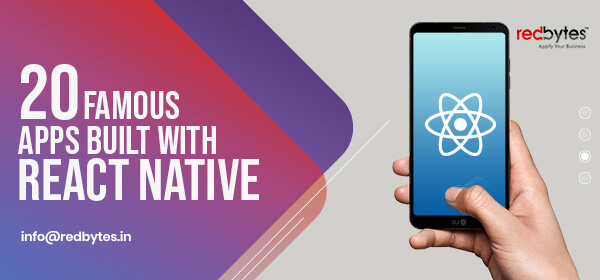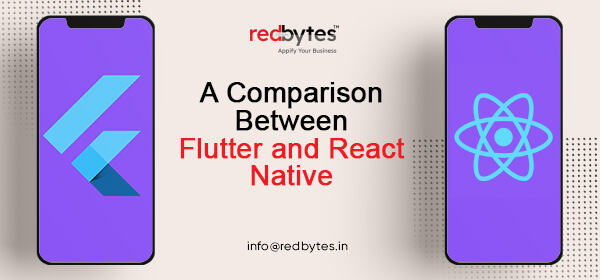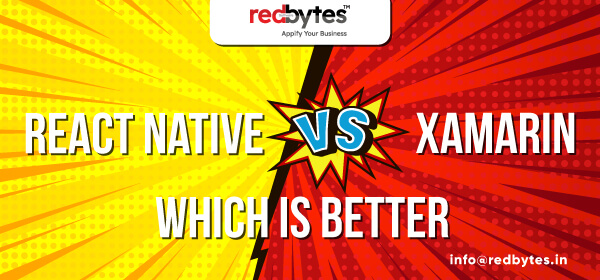What is React Native?
React Native is a JavaScript framework which is used for developing mobile applications for iOS and Android. It uses the React framework and offers large amount of inbuilt components and APIs.
Discovery of React Native by Facebook was an intriguing phenomenon since Mark Zuckerberg announced how amazing this framework is for mobile app developers.
It is because of its potential to bring all the basic features of web development in mobile platform that captured a lot of attention among both app entrepreneurs and developers.
Ever since its introduction to mobility world, React Native as a complete cross-platform app development framework continued to drive a lot of interest and global adoption.
When a framework is believed to be beneficial for mobile app developers, its myriad benefits also automatically appeal to entrepreneurs with its ability to reduce cost and time.
However, to understand that the limelight React Native is getting is not too exaggerated and it is comparatively better than native app development, we are going to go through a tutorial of this framework in the following discussion.
This tutorial will help beginners in the space of React Native development broaden their perspective about the technology and know what all factors they should consider when opting for React Native for mobile app development through this tutorial.
Who Invented React Native?
This open-source mobile application framework was created by Jordan Walke, a software engineer at Facebook. He released an early prototype of React called “FaxJS”.
React was first deployed on Facebook’s News Feed in 2011 and later on Instagram in 2012. In May 2013, React was open-sourced at JSConf US.
In this tutorial, we shall have a broad view about react native and also have some topics should go through before starting learning.
What is difference between React JS and react native?

Due to obvious presence of React in React Native framework, entrepreneurs and beginners often get confused about their exact use and applications in the world of development.
It is therefore important to imbibe the fundamental difference between React and React Native technologies. React uses React DOM for rendering web development solutions while React Native stands as a custom solution for rendering React files for mobile equivalent.
React Native uses native components as building blocks for developing mobile apps unlike React that uses web components. As a first-time learner of React Native, it is inevitable that you must gather enough basic overview of the React concepts such as its class, components, JSX, state and more.
Even if you have know how about React, you will have to explore the Native components of React Native that makes React code work for Android and iOS.
Read Also: Difference Between React JS and React Native
With the deep confusion around React Native now clarified, it is time to focus on the business-oriented benefits of using React Native over other cross-platform frameworks and tools.
The upper hand of React Native over other frameworks

- Intuitive User Interface
- Advantage of JavaScript
- Ease of setup and configuration
- Mature, impeccable structure
- User-friendly development environment
- Diversity of invaluable tools
- Easy to learn and adopt
- Impressive performance
- Community Support
- Efficient Testing
- Proper Documentation
- Affordability and economy
- Better Lifecycle Management
React Native: Pros and Cons
Of course, like any framework, perfection and imperfection both co-exists in React Native framework although the cross-platform technology boasts of more pros than cons for active react native app developers.
Cultivating basic insight into all the benefits and limitations will help fuel the development process and make developers more proactive, vigilant and confident in their space.
Pros
Slim Coding: Write once run everywhere
The most exhilarating part about working with React Native app development is that it allows you to adopt single code base for all platforms (Android, iOS, Windows).
This goes to imply that the team of Native developers would not have to write separate codes for different target platforms. They can follow write-once-run-everywhere approach, having to code the app just once and make it live across available platforms.
Rapid App Development

Another pro that is most likely to be the comforting answer to React Native conundrum is that the framework facilitates rapid app development, minimizing both the team size as well as time required to finish the project.
The mobile app development company does not need to involve too many developers especially to individually work for all platforms. As single team is enough to look after all the requirements efficiently and project doesn’t demand extensive timeline, the overall efforts for design, development and testing are too massive.
Read Also: React Native App Development Company in UK
Lean Learning Curve for Web Developers
React Native is based on JavaScript and existing web developers who possess good familiarity with this JS can easily get their hands on React Native app development.
Hence, it is not a massive struggle if you want to learn and eventually switch to mobile app development using React Native as a core technology in this tutorial.
Open Source

At the start of any mobile app development project, developers emphatically seek open source nature of the technologies being used. React Native, being the open source, thus pleases developers by allowing them to freely inspect code.
Not only that, due to being open source, its library is generous and updated with components that even work for rare platforms like tvOS.
Comfortable team composition
The nature of React native development is such that it also comforts entrepreneurs who often brood over assembling great number of developers to create a huge team.
The framework allows you to dispense with a small size of development team which is composed with merely:
- Tech consultant
- Project Manager
- React Native Developer
- UI/UX Designers
- Business Analyst
- QA Specialist
In case of pure native app development, you may end up choosing almost double the number or more is depending on the project size.
How much does react native cost?

The cost factor of mobile app development that drives major concern for businesses also works in their favor. React native app development brings down the spending which is another great benefit for both developers building the app and entrepreneurs worried about ROI.
This means having a dream about mobile app development does not necessarily mean you will bear enormous cost if it is done using React Native – another reason why the technology is so popular as an effective way to reduce the investment.
React Native example
Here are a list of some popular apps built using React Native
- Snapchat
- Tinder
- AirBnB
- Myntra
Read Also: 13 Famous Apps Built With React Native
Scalability for future
Even after hearing about its several incredible benefits, what developers and app entrepreneurs worry about is whether or not React Native is flexible and versatile enough to fulfill unpredictable scope of app scalability in future.
As business grows and marketplace evolves, the need to meet the loads of requirements of increased real-time users becomes inevitable. To their relief, this overwhelming expectation is fulfilled efficiently by the flexible capability of React Native cross-platform framework.
If developers are experienced and aware of how they can tune React Native structure to handle increased volume of customer activities, your app can be as successful as one of those big brands like Facebook, Instagram, Airbnb or Walmart. They are all powered by versatile React Native.
Hot Reload Option
Another technical aspect that developers ponder over while figuring out technologies is the amount of time consumed when actually writing and running application code. Thankfully enough, React Native affords hot reload solution which is a brilliant time-saving functionality.
With this capability in place, developers find it easy to view in real time how any change in code appears in target device. The action of checking the effect does not demand burdensome efforts, which lucidly proves that React Native has developer-friendly environment.
Cons
Poor connection with device’s Native environment

A little unpleasant blow for React Native developers is that it does not directly interact with device’s native elements such as Camera, Voice recorder, etc. this is the kind of challenge that even its closest alternatives like Xamarin and Flutter don’t seem to solve completely.
Hence, in certain technical dilemma, native app development outweighs the cross-platform capability of React Native to an extent.
Limited Native APIs
In React Native, developers are restricted from using certain Native APIs as there isn’t much support for all Native APIs. However, the technology is working on providing support for those Native APIs. For now, this is one of the plights where Native app development seems to overshadow React Native power.
Insufficient Third-Party Libraries

Another down point in React Native development is that it lacks third-party libraries. Developers have to depend on native modules to leverage libraries – which somewhat adds to development efforts in the long run.
Adoption rate of React Native
By mentioning all the pros and limitations associated with using React Native for cross-platform development, we could clearly see how React Native, when compared with other tools or app development methods, emerges stronger and more reliable.
The reason why React Native still holds its significance and is widely adopted is that it has all the functionalities developers need for cross-platform development process.
Pros the framework offers are too great to be overwhelmed by its limitations, or by native app development approach. This is why there is a steep rise and interest in adopting React Native for creating sophisticated, business-class mobile apps.
To understand the size of React Native’s adoption by global businesses, we must be driven to take a good look at those eminent big brand names that turned to RN to build the backbone of their applications.
Who are using react native?
Apart from the companies that are now starting to feel positive about React Native for mobile app development, here is the glance at globally recognized applications:
- Bloomberg
- Tesla
- Uber
- Walmart
- SoundCloud
- Townske
- Gyroscope
- Vogue
Why we use React Native?
The reasons to use React Native are that it is a popular framework that is used to build web applications. React popularized the use of a virtual DOM, this in turn greatly increased render performance for web apps.
This open-source mobile application framework maintains a virtual representation of the view hierarchy. So, when changes are made, you no longer have to do expensive operations on the view hierarchy.
React uses an efficient diffing algorithm to compare the virtual hierarchy and then necessary changes are made to the actual view hierarchy.
Encapsulation of components is another fascinating principle of React. React encapsulates each single component into a single file. With React Native, you can save a lot of compile time.
React Native helps build app that can work across multiple types of platforms including iOS and Android. This cross-platform feature helps large or small company to save their time and money.
React Native has Rich Text Editor which helps increase the overall productivity. The key benefits of Rich Text Editor are that it will not crash, hang and lose syntax highlighting.
React Native: Possibilities and Potential
While the world of developers and entrepreneurs are still hoping to use React Native for applications of any kind, in the moment the type of mobile apps that can be built with the framework are categorized as:
Simple and intuitive UI

React Native helps develop mobile apps with simple, interactive and intuitive user interface. Since the technology offers unparalleled capabilities like hot reloading and slim coding, it is a viable solution for building a high-performance mobile app with best UI elements and features.
Strategic Prototypes
The mobile app industry deeply believes in first generating the app prototypes in order to validate the idea before plunging further in. App prototyping is another need addressed by React Native because of its ability to deliver the software model in less time.
Also, the cross-platform framework makes the entire process of prototype creation less costly than other frameworks in the app development market.
Basic functionalities
For an app built without deep complexities or any challenging functionalities, React Native could be the best option to look forward to. You can easily consider it suitable for mobile apps with not many heavy functionalities to go.
Industry-specific apps
Since React Native does not typically provide you with much ground to fiddle with native device elements, apps that don’t directly interact with native features can be perfect for React Native development.
Still, React Native has bred apps for huge brands as seen above – apps that don’t solely exist as an independent software. For instance, Facebook, Instagram and Uber are all using real-time features that require making connection with local device setup.
Hence, it is important to notice that React Native framework can be used as a versatile and adaptive structure to build industry-specific apps.
Read Also: Comparison Between Flutter Vs React Native
What is the future of react native?
A survey conducted by Stack Overflow Developer in 2018 reveals that React is the framework that every developers wants to work with and also many developers are interested in React Native. The future of React Native is fabric and it boils down to three major internal changes.
- New threading model – A new threading model makes it possible to call synchronously into JavaScript on any thread, maintaining responsiveness while keeping low-priority work off the main thread.
- Async rendering capabilities – Async rendering capabilities will be incorporated into React Native.
- Simplified bridge – A new simplified bridge will make direct calls between native and JavaScript and make it easier to build various debugging tools.
Sophie Alpert, Engineering Manager on React at Facebook says that existing React Native apps will remain fully functional with no or just a few changes.
How do I become a React Native developer?
The following step by step procedure will help you become a good React Native developer.
- Sharpen your basics from tutorial on react native app development
- Learn to build static web pages such as Html, CSS
- Learn Javascript-ES6/7/8
- Learn basic Nodejs and npm
- Learn basic React
- Learn Redux
- Dive in to React Native
- Learn React Navigation
Words in nutshell
By ending the tutorial, we can firmly say that Facebook’s React Native equally benefits both front-end developers and web developers wanting to dip into the pool of opportunities pertaining to mobile app development.
Having in-depth knowledge about React, which is a declarative view library of Facebook for web development, can also lead to gaining mastery in native mobile app development with React Native.
Given how React Native triumphs over other cross-platform tools when it comes to building diverse mobile apps for iOS and Android, it is crucial to learn this incredible framework and ensure a competitive advantage in the business.
The framework also offers simplicity and flexibility along with the power to create the imagined. Hope in this tutorial about react native app development, we cover all the basics that one should consider before learning it.
Exclusive Bonus: Download PDF










































